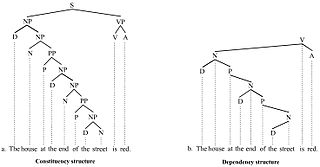In linguistics, syntax is the set of rules, principles, and processes that govern the structure of sentences in a given language, usually including word order. The term syntax is also used to refer to the study of such principles and processes. The goal of many syntacticians is to discover the syntactic rules common to all languages.
In computational linguistics, word-sense disambiguation (WSD) is an open problem concerned with identifying which sense of a word is used in a sentence. The solution to this problem impacts other computer-related writing, such as discourse, improving relevance of search engines, anaphora resolution, coherence, inference.
Natural-language understanding (NLU) or natural-language interpretation (NLI) is a subtopic of natural-language processing in artificial intelligence that deals with machine reading comprehension. Natural-language understanding is considered an AI-hard problem.
Head-driven phrase structure grammar (HPSG) is a highly lexicalized, constraint-based grammar developed by Carl Pollard and Ivan Sag. It is a type of phrase structure grammar, as opposed to a dependency grammar, and it is the immediate successor to generalized phrase structure grammar. HPSG draws from other fields such as computer science and uses Ferdinand de Saussure's notion of the sign. It uses a uniform formalism and is organized in a modular way which makes it attractive for natural language processing.
Charles J. Fillmore was an American linguist and Professor of Linguistics at the University of California, Berkeley. He received his Ph.D. in Linguistics from the University of Michigan in 1961. Fillmore spent ten years at The Ohio State University and a year as a Fellow at the Center for Advanced Study in the Behavioral Sciences at Stanford University before joining Berkeley's Department of Linguistics in 1971. Fillmore was extremely influential in the areas of syntax and lexical semantics.
Linguistic competence is the system of linguistic knowledge possessed by native speakers of a language. It is distinguished from linguistic performance, which is the way a language system is used in communication. Noam Chomsky introduced this concept in his elaboration of generative grammar, where it has been widely adopted and competence is the only level of language that is studied.
The American National Corpus (ANC) is a text corpus of American English containing 22 million words of written and spoken data produced since 1990. Currently, the ANC includes a range of genres, including emerging genres such as email, tweets, and web data that are not included in earlier corpora such as the British National Corpus. It is annotated for part of speech and lemma, shallow parse, and named entities.

In linguistics, a treebank is a parsed text corpus that annotates syntactic or semantic sentence structure. The construction of parsed corpora in the early 1990s revolutionized computational linguistics, which benefitted from large-scale empirical data. The exploitation of treebank data has been important ever since the first large-scale treebank, The Penn Treebank, was published. However, although originating in computational linguistics, the value of treebanks is becoming more widely appreciated in linguistics research as a whole. For example, annotated treebank data has been crucial in syntactic research to test linguistic theories of sentence structure against large quantities of naturally occurring examples.
Sentence processing takes place whenever a reader or listener processes a language utterance, either in isolation or in the context of a conversation or a text.
Glue semantics, or simply Glue, is a linguistic theory of semantic composition and the syntax–semantics interface which assumes that meaning composition is constrained by a set of instructions stated within a formal logic. These instructions, called meaning constructors, state how the meanings of the parts of a sentence can be combined to provide the meaning of the sentence.
In computer science, SYNTAX is a system used to generate lexical and syntactic analyzers (parsers) for all kinds of context-free grammars (CFGs) as well as some classes of contextual grammars. It has been developed at INRIA (France) for several decades, mostly by Pierre Boullier, but has become free software since 2007 only. SYNTAX is distributed under the CeCILL license.
Rule-based machine translation is machine translation systems based on linguistic information about source and target languages basically retrieved from dictionaries and grammars covering the main semantic, morphological, and syntactic regularities of each language respectively. Having input sentences, an RBMT system generates them to output sentences on the basis of morphological, syntactic, and semantic analysis of both the source and the target languages involved in a concrete translation task.
The following outline is provided as an overview of and topical guide to natural language processing:
Minimal recursion semantics (MRS) is a framework for computational semantics. It can be implemented in typed feature structure formalisms such as head-driven phrase structure grammar and lexical functional grammar. It is suitable for computational language parsing and natural language generation. MRS enables a simple formulation of the grammatical constraints on lexical and phrasal semantics, including the principles of semantic composition. This technique is used in machine translation.
In computational linguistics, the term mildly context-sensitive grammar formalisms refers to several grammar formalisms that have been developed with the ambition to provide adequate descriptions of the syntactic structure of natural language.
Semantic parsing is the task of converting a natural language utterance to a logical form: a machine-understandable representation of its meaning. Semantic parsing can thus be understood as extracting the precise meaning of an utterance. Applications of semantic parsing include machine translation, question answering and code generation. The phrase was first used in the 1970's by Yorick Wilks as the basis for machine translation programs working with only semantic representations.

